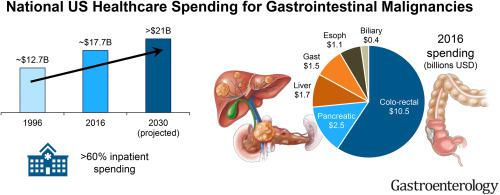Gastroenterology ( IF 25.7 ) Pub Date : 2021-12-16 , DOI: 10.1053/j.gastro.2021.12.244 Igor Stukalin 1 , Newaz Shubidito Ahmed 2 , Adam M Fundytus 3 , Alexander S Qian 4 , Stephanie Coward 5 , Gilaad G Kaplan 6 , Robert J Hilsden 7 , Kelly W Burak 5 , Jeffrey K Lee 8 , Siddharth Singh 4 , Christopher Ma 6

|
Background & Aims
The management of gastrointestinal (GI) cancers is associated with high health care spending. We estimated trends in United States (US) health care spending for patients with GI cancers between 1996 and 2016 and developed projections to 2030.
Methods
We used economic data, adjusted for inflation, developed by the Institute for Health Metrics and Evaluations for the Disease Expenditure Project. Corresponding US age-adjusted prevalence of GI cancers was estimated from the Global Burden of Diseases Study. Prevalence-adjusted temporal trends in the US health care spending in patients with GI cancers, stratified by cancer site, age, and setting of care, were estimated using joinpoint regression, expressed as annual percentage change (APC) with 95% confidence intervals (CIs). Autoregressive integrated moving average models were used to project spending to 2030.
Results
In 2016, total spending for GI cancers was primarily attributable to colorectal ($10.50 billion; 95% CI, $9.35–$11.70 billion) and pancreatic cancer ($2.55 billion; 95% CI, $2.23–$2.82 billion), and primarily for inpatient care (64.5%). Despite increased total spending, more recent per-patient spending for pancreatic (APC 2008–2016, −1.4%; 95% CI, −2.2% to −0.7%), gallbladder/biliary tract (APC 2010–2016, −4.3%; 95% CI, −4.8% to −3.8%), and gastric cancer (APC 2011–2016, −4.4%; 95% CI, −5.8% to −2.9%) decreased. Increasing price and intensity of care provision was the largest driver of higher expenditures. By 2030, it is projected more than $21 billion annually will be spent on GI cancer management.
Conclusions
Total spending for GI cancers in the US is substantial and projected to increase. Expenditures are primarily driven by inpatient care for colorectal cancer, although per-capita spending trends differ by GI cancer type.
中文翻译:

美国全国胃肠道恶性肿瘤医疗保健支出的趋势和预测(1996 年至 2030 年)
背景与目标
胃肠道 (GI) 癌症的管理与高医疗保健支出有关。我们估计了 1996 年至 2016 年间美国 (US) 胃肠道癌症患者的医疗保健支出趋势,并制定了到 2030 年的预测。
方法
我们使用了由健康指标和评估研究所为疾病支出项目开发的经通货膨胀调整后的经济数据。相应的美国胃肠道癌症年龄调整患病率是根据全球疾病负担研究估算的。美国胃肠道癌症患者医疗保健支出的患病率调整时间趋势,按癌症部位、年龄和护理环境分层,使用连接点回归估计,表示为年度百分比变化 (APC) 和 95% 置信区间 (CIs) ). 自回归综合移动平均模型用于预测到 2030 年的支出。
结果
2016 年,GI 癌症的总支出主要归因于结直肠癌(105 亿美元;95% CI,935-117 亿美元)和胰腺癌(25.5 亿美元;95% CI,2.23-28.2 亿美元),主要用于住院治疗(64.5 %)。尽管总支出有所增加,但最近每位患者的胰腺支出(APC 2008-2016,-1.4%;95% CI,-2.2% 至 -0.7%)、胆囊/胆道(APC 2010-2016,-4.3%;95% CI,-2.2% 至 -0.7%) 95% CI,-4.8% 至 -3.8%)和胃癌(APC 2011–2016,-4.4%;95% CI,-5.8% 至 -2.9%)下降。提高护理服务的价格和强度是增加支出的最大驱动力。到 2030 年,预计每年将有超过 210 亿美元用于胃肠道癌症管理。
结论
美国用于胃肠道癌症的总支出数额巨大,预计还会增加。支出主要由结直肠癌的住院治疗驱动,尽管人均支出趋势因胃肠道癌症类型而异。











































 京公网安备 11010802027423号
京公网安备 11010802027423号